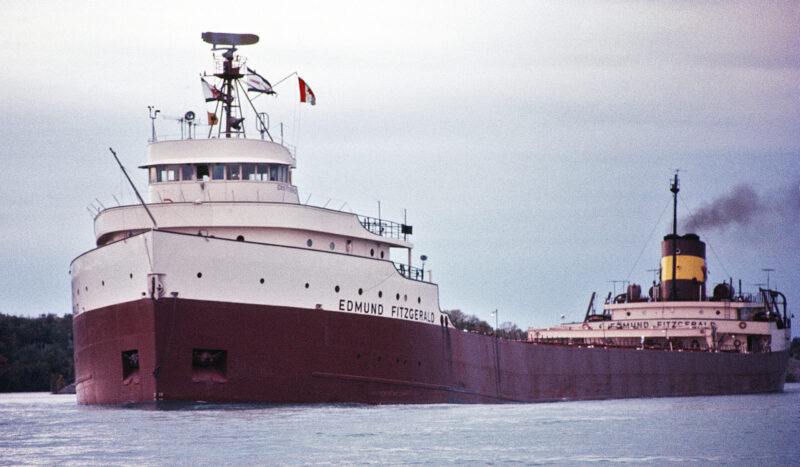The sinking of the Edmund Fitzgerald, 50 years later

**The Sinking of the Edmund Fitzgerald: 50 Years Ago in Lake Superior**
The Edmund Fitzgerald sank in Lake Superior during a fierce storm 50 years ago, on November 10, 1975. It remains one of the Great Lakes’ most famous shipwrecks, claiming the lives of 29 men. Lake Superior is known as the lake that “never gives up her dead,” and there’s a scientific reason why.
—
### The Edmund Fitzgerald: A Tragic Night
The SS Edmund Fitzgerald was a 729-foot iron ore freighter carrying more than 26,000 tons of taconite pellets—balls of iron ore concentrate—bound for a steel mill near Detroit. The ship sailed out of Superior, Wisconsin, on the afternoon of November 9, 1975, with 29 crew members on board.
On that same day, meteorologists issued a gale warning for Lake Superior, forecasting winds between 34 and 47 knots (39 to 54 mph). The following morning, November 10, forecasters upgraded the warning to a storm warning, calling for winds of 48 to 55 knots (55 to 63 mph) and waves 8 to 15 feet (2.4 to 4.5 meters) high.
However, the storm that battered Lake Superior exceeded expectations, with wind gusts reaching up to 75 knots (86 mph) and waves as high as 35 feet (11 meters).
—
### The Last Communications
Ernest McSorley, captain of the Edmund Fitzgerald, radioed other ships frequently about the severe conditions his vessel faced. At around 3:30 p.m., he communicated with the Arthur M. Anderson:
> “Anderson, this is the Fitzgerald. I have sustained some topside damage. I have a fence rail laid down, two vents lost or damaged, and a list. I’m checking down. Will you stay by me till I get to Whitefish?”
About an hour later, he radioed the captain of the Avafors:
> “I have a bad list, I have lost both radars, and am taking heavy seas over the deck in one of the worst seas I have ever been in.”
The final known communication came just after 7 p.m. when McSorley told the Arthur M. Anderson:
> “We are holding our own.”
Not long after, the Edmund Fitzgerald disappeared from radar off the coast of Whitefish Point, Michigan. The ship now lies in two pieces some 530 feet below the surface. Sadly, no bodies were ever recovered.
—
### Why Lake Superior “Never Gives Up Her Dead”
The haunting lyric from Gordon Lightfoot’s song “The Wreck of the Edmund Fitzgerald” declares:
> “The legend lives on from the Chippewa on down
> Of the big lake, they called Gitche Gumee
> The lake, it is said, never gives up her dead.”
This haunting phrase reflects more than just folklore—there’s a scientific explanation behind it.
Lake Superior is the coldest and deepest of the Great Lakes, with temperatures averaging below 40°F (4°C) even in summer. Such cold water slows the natural decomposition processes dramatically.
In warmer waters, drowning victims often resurface because the bacteria inside the body create gases during decomposition, causing the body to float. But in the frigid waters of Lake Superior, bacterial activity is minimal or halted, preventing gas buildup. As a result, bodies tend to remain at the bottom, preserved by the cold.
—
### Other Shipwrecks and Preservation Underwater
Lake Superior is the final resting place for some 550 shipwrecks, with around 200 still undiscovered. Among these is the SS Kamloops, which sank in 1927.
Divers discovered the Kamloops in 1977 off the north shore of Isle Royale. The ship and its crew were remarkably preserved. As described in Geo Rutherford’s book *Spooky Lakes*:
> “They looked as fresh as the day they drowned. One crewmate, known as ‘Old Whitey,’ was found in the boiler room, floating eerily as underwater currents made it seem like the body was following the divers.”
Rutherford explains that the cold freshwater conditions promote a chemical reaction between minerals in the water and human skin called adipocere formation, or saponification. This process transforms body fat into a soap-like substance, effectively halting decay and preserving bodies like a “soap mummy” for potentially hundreds of years.
—
### Remembering the Edmund Fitzgerald
The sinking of the Edmund Fitzgerald on November 10, 1975, remains a powerful reminder of the Great Lakes’ dangers and mysteries. Resting deep in Lake Superior, it symbolizes the lake’s eerie reputation for never giving up her dead—and the scientific reasons behind this haunting truth.
—
*Support independent science journalism. EarthSky is powered by readers like you. Help us keep science accessible by supporting EarthSky’s 2025 Donation Campaign.*
https://earthsky.org/human-world/sinking-of-the-edmund-fitzgerald-never-gives-up-her-dead/






